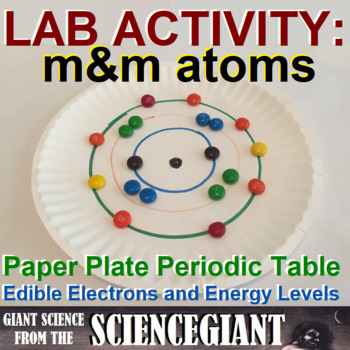Lab: Paper Plate Periodic Table and m&m Atoms - Energy Levels and Electrons
- Word Document File
What educators are saying
Also included in
- All of the materials including in this bundled Strategic Instruction download are available as individual products sold separately on TpT in the ScienceGiant store. Please click on each link to receive a detailed description. [BE ALERT TO STUDENT’S FOOD ALLERGY WARNINGS! Products may contain nut andPrice $5.60Original Price $8.00Save $2.40
Description
Students study the structure of the atom with m&m's atoms on a paper plate periodic table! This lab investigation on edible "electrons" and elements explores the Essential Question: How are Elements Arranged in the Periodic Table? And, How Are Electrons Configured in an Atom?"
Share with your students edible electrons; EX: m&m's, skittles, smarties, cereal, or mini-marshmallows. Ss will model atoms of elements using a paper plate and different sorts of sweets. At the end of the lab, when Ss have correctly demonstrated their understanding of atomic number and the Bohr model of the atom, Ts may wish to let them eat their models. (WARNING: BE ALERT TO STUDENTS FOOD ALLERGIES! Food products may contain nut and other allergens).
UPDATE 2021: whole class activity to compliment the paper plate atoms "Envelopes of Elements, File Folders of Families". Ss are given cards of the elements, and asked to choose in which group they belong. Includes a GIANT Periodic Table of the Elements, spanning twelve 8 1/2" by 11" pages when assembled, but also to be cut into cards for the class.
All activities are in Microsoft Word .doc form so that Ts can customize the discussion to fit the needs of Ss.
Yet since the electron cloud model is the accepted model of the atom, this product includes an extension activity. If the Bohr model is like imagining a neon atom with a paper plate with m&m’s on it, then the electron cloud model is like imagining neon with a pinch of Play-doh, a plastic bag, and a dozen paper clips. Ss will recreate the first two energy levels of the 1s, 2s, and 3 2p suborbitals in a simple, straight forward construction with office supplies. Preview here at https://youtu.be/7ewhFWFSzSo
This activity has the following lesson objectives. Students Will Be Able To (SWBAT):
• describe the patterns that exist in the electron configurations for the main group elements, such as elements in the periodic table are organized by atomic number.
• relate an element's position in the Periodic Table to the energy level of its valence electrons (excluding transition metals, lanthanides, and actinides).
• explain why there are only two elements in the first row of the Periodic Table.
• identify the columns in the Periodic Table that contain 1) the alkali metals, 2) the alkaline earth metals, 3) the halogens, and 4) the noble gases, and describe the differences between each family's electron configuration.
• given the outermost energy level electron configuration for an element, determine its family on the Periodic Table.
These labs are classroom tested to help students with the following Florida Next Generation Sunshine State Standards in Science:
• SC.8.P.8.6 Recognize that elements are grouped in the periodic table according to similarities in their properties.
• SC.8.P.8.7 Explore the scientific theory of atoms (also known as atomic theory) by recognizing that atoms are the smallest unit of an element and are composed of sub-atomic particles (electrons surrounding a nucleus containing protons and neutrons).[CCSS Connections: MACC.K12.MP.4: Model with mathematics].
• SC.912.P.8.3 Explore the scientific theory of atoms (also known as atomic theory) by describing changes in the atomic model over time and why those changes were necessitated by experimental evidence.
• SC.912.P.8.4 Explore the scientific theory of atoms (also known as atomic theory) by describing the structure of atoms in terms of protons, neutrons and electrons, and differentiate among these particles in terms of their mass, electrical charges and locations within the atom.
• SC.912.P.8.5 Relate properties of atoms and their position in the periodic table to the arrangement of their electrons.
Related Resources
- Question Exploration and Concept Comparison Frame: How Are Electrons Configured in an Atom?
- Question Exploration and Frame: How are Elements Arranged in the Periodic Table?
- Question Exploration and Concept Comparison: Atomic Models and Parts of the Atom
- Logic LineUp: Atomic/Subatomic Particle Puzzle (Proton, Neutron, and Electron)
- Logic LineUp: Periodic Table Trends Puzzle (Metals, Nonmetals, SemiMetals)
- Lab: Half-Life Labs with M&M's, Licorice, and Plain Paper
__________
#StayGiant and stay up on my new resources and STEM news. Look for the green ★ star near the top of any page within my store and click "FOLLOW". Stand on the Shoulders of Giants, and together we'll see further, inspire students, and enlighten inquisitive minds!
Help others #StandOnTheShouldersOfGiants -- leave a review for this resource! And it helps you #SeeFurther too -- you earn 1 credit for every $1 spent on TpT resources. Each credit has a value of 5 cents, so 20 credits earned equals $1 to apply to future TpT purchases.






